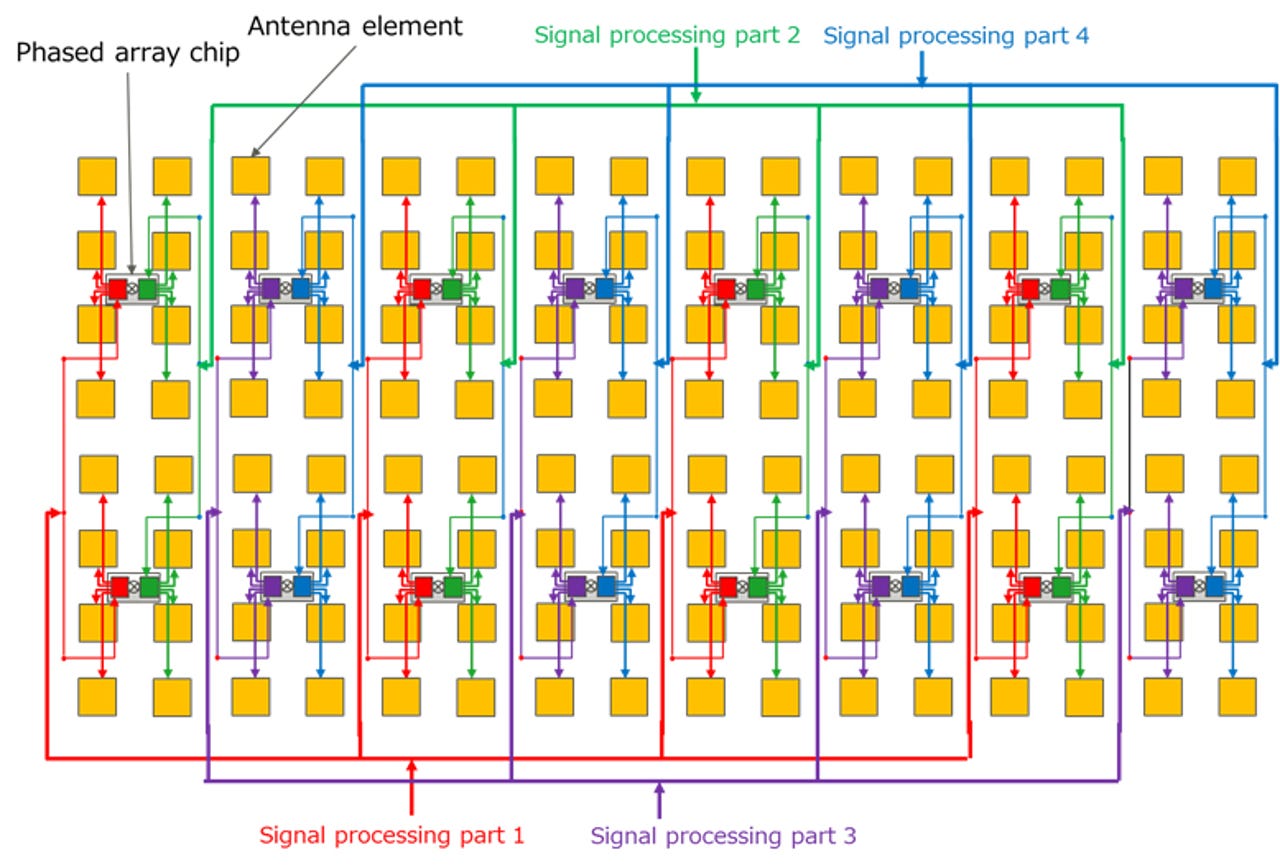Fujitsu unveils 10Gbps single-panel 5G antenna


Fujitsu Laboratories has unveiled a single-panel antenna designed to enable multiple 5G connections on a small, energy-efficient base station, saying it could be used across train stations and stadiums.
The antenna provides speeds of more than 10Gbps across four simultaneous 2.5Gbps signals, using the millimetre-wave (mmWave) 28GHz 5G spectrum band, with 128 antenna elements, and 16 phased array chips that fit onto a single 13cm square printed circuit board.
"Conventional 5G system structures require use of an antenna panel for each terminal when simultaneously transmitting to multiple terminals. Now, by controlling with high accuracy the phase (angle) of signals separately emitted from 128 antenna elements, Fujitsu Laboratories has suppressed the interference between signals," the company explained.
"Currently, to avoid radio wave interference during communications with multiple users at once, base stations have been configured to use a number of antenna panels corresponding to the number of concurrent users. To miniaturise the equipment so that it can be deployed anywhere, the best option is to provide multi-directional transmissions from a single antenna panel."
To achieve this, Fujitsu developed a phased array chip that is able to regulate the phase of a signal propagated with an accuracy of one degree or less from an antenna element. It then built one phased array chip per eight antenna elements into the panel.
"The company also uses circuitry that detects the differences in phase between phased array chips, which enables highly accurate phase control for any size antenna panel that has between 64 and 256 antenna elements," it said.
"As a result, by holding the difference in undesired emissions intruding between one radio wave communicating with a device and another radio wave with another device to 20dB or more, it makes it possible for a single antenna panel to carry out high-capacity communications of 10Gbps or more."
Fujitsu is planning to commercialise the technology in 2021.
The announcement follows the company last month signing a 5G partnership with networking giant Ericsson, with plans to combine their radio access and core network portfolios to deliver 5G mobile network services and solutions across Japan.
"Ericsson and Fujitsu's strength in research and development will ensure the best path for bringing global 5G solutions to Japan, as well as exploring a wider global market," the companies said in November.
Fujitsu will provide open and standards-based "flexible 5G network systems" using its wireless technology expertise, Fujitsu EVP and head of Network Business Group Tango Matsumoto said.
Fujitsu's previous work on 5G saw it kick off a field trial last year of its 5G ultra high-density distributed antenna technology and tests of simultaneous high-speed transmission of high-res video using the antenna system, in partnership with Japanese carrier NTT DoCoMo.
Fujitsu and Fujitsu Laboratories, which have been working on 5G trials with NTT DoCoMo since 2014, have also collaborated with the Japanese carrier on evaluating communications speed for distributed antennas deployed at multiple outdoor locations.
"The testing system consists of two mobile stations equipped with displays that can be moved around the interior of Fujitsu Shin-Kawasaki Technology Square, as well as equipment including distributed antennas installed in 16 locations, centralised baseband processing equipment that controls the distributed antennas, and fibre-optic cables connecting the distributed antennas with the centralised baseband processing equipment," Fujitsu explained in November 2017.
Fujitsu's ultra-high density distributed antenna technology "actively controls the shape of cells, which are the range of a signal, in order to improve communication quality for mobile stations through centralised control of base station antennas distributed around a space at high density", it said.
Fujitsu said the 32 distributed antennas can be controlled by the centralised baseband processing devices. This is done by using signal processing equipment that aggregates digital signals -- transmitted and received -- from several different distributed antennas while preventing signal interference.
Fujitsu also unveiled its millimetre-wave (mmWave) phase shifter for small cells a year ago, which it said delivers the 10Gbps connections required by 5G, while maintaining low power usage.
According to Fujitsu, its phase shifters reduced the number of amps needed by combining switching circuits with differential amps, and using a new mmWave circuit limited the electrical loss of circuits.
Its small cell technology -- which Fujitsu said it was looking to offer by 2020 -- also makes use of beam-forming, with the company saying it controls 128 antenna elements.
Earlier this month, Fujitsu also said it is working on developing palm vein and facial data authentication technology, with the integrated biometric identification capabilities pointing to a cashless society.
According to Fujitsu, its Laboratories have developed a simulation algorithm enabling instant facial recognition processing.
Related Coverage
The promise of 5G for the enterprise and beyond (TechRepublic)
There are two key sets of opportunities for the enterprise with 5G, according to a new PwC study.
5G mobile networks: A cheat sheet (TechRepublic)
As LTE networks become increasingly saturated, mobile network operators are planning for the 5G future. Here is what business professionals and mobile users need to know about 5G networks.
Ericsson and Fujitsu partner on 5G
Ericsson and Fujitsu will combine their expertise across radio access and core network technology to offer 5G services and solutions across Japan and globally.
Fujitsu develops palm vein and facial data authentication technology
The company hopes to make the technology 'practical' within fiscal 2020.
5G will be the key to unlocking the full potential of IoT and a host of other technologies. Businesses can get a jump on their competition if they apply the power of 5G to their products and services first.